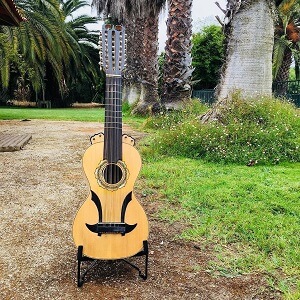Guitarron Chileno
 The Chilean guitarron is a cordophone that has 25 strings, grouped into five quintuple and sixfold orders along the mast, also presenting four simple strings outside it, called "diablitos". This instrument clearly belongs to the guitar family, although its exclusive evolution in Chile, has made it a unique example within that family, due to its large number of strings.
The Chilean guitarron is a cordophone that has 25 strings, grouped into five quintuple and sixfold orders along the mast, also presenting four simple strings outside it, called "diablitos". This instrument clearly belongs to the guitar family, although its exclusive evolution in Chile, has made it a unique example within that family, due to its large number of strings.
The "shot" of the instrument, i.e. the distance between the two bridges, ranges from 46 to 64 centimeters. The lower bridge needs a very powerful fixation to withstand the enormous pressure of the metal ropes, and is usually adorned with ornaments called "daggers".
Carlos Lavín in his book "El Rabel y los instrumentos Chilenos" mentions this guitarron as "one of the most original in the New World" and as "an honorable representation in America of the European proliferation of string instruments of the Late Middle Ages and the Renaissance". The history of the Chilean guitarron is linked to that of the payers and their so-called "Canto a lo Poeta", "Canto a lo Divino", "Canto de Velorio", etc., in the Province Cordillera, and mainly in the commune of Pirque (Chile).